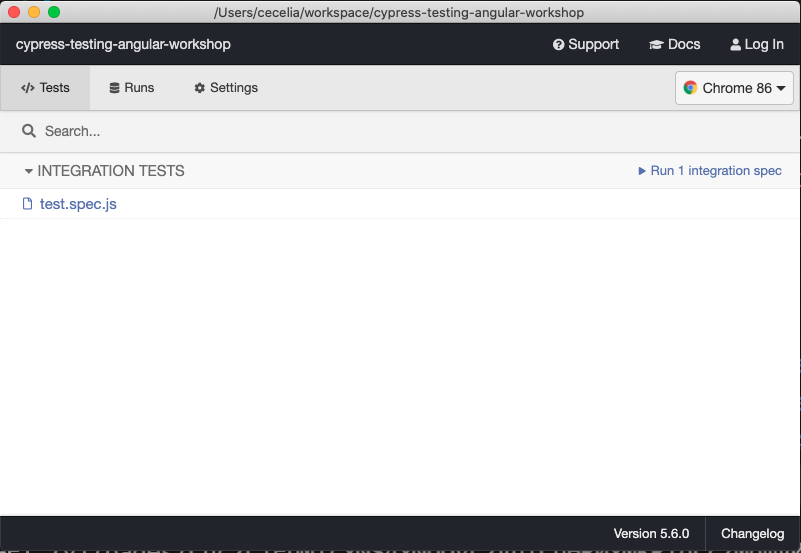Please complete the following steps to prepare for the workshop. It may take a few minutes to install all the dependencies on your system.
Please check the Cypress system requirements here to ensure you have all the dependencies needed.
Additionally, you'll need the following:
- An IDE or Code Editor (VS Code recommended)
- NPM or Yarn (Yarn recommended)
- Angular CLI (recommended, not required)
- Clone the repository locally. Make sure you are on the
starterbranch. - Run
yarn installornpm installin the project directory. - If you have the Angular CLI installed, run
ng serve. Otherwise, runyarn run startto start the dev server. Confirm the application runs locally. - In a new terminal, run
yarn run cypress openornpx cypress open - Confirm the Cypress Test Runner opens on your machine. You should see a Graphical User Interface (GUI) like the screenshot below:
- If the application runs and the Test Runner appears, you are ready for the workshop! You can stop both servers.
The Application Under Test is a fork of gothinkster/angular-realworld-example-app.
Below is the application description from its README. Check out the repository directly for more details about the application.
Angular codebase containing real world examples (CRUD, auth, advanced patterns, etc) that adheres to the RealWorld spec and API.
This codebase was created to demonstrate a fully fledged application built with Angular that interacts with an actual backend server including CRUD operations, authentication, routing, pagination, and more. We've gone to great lengths to adhere to the Angular Styleguide & best practices.
For convenience, we have a live API server running at https://conduit.productionready.io/api for the application to make requests against. You can view the API spec here which contains all routes & responses for the server.
The example application is a social blogging site (i.e. a Medium.com clone) called "Conduit". It uses a custom API for all requests, including authentication. You can view a live demo over at https://angular.realworld.io
- Authenticate users via JWT (login/signup pages + logout button on settings page)
- CRU* users (sign up & settings page - no deleting required)
- CRUD Articles
- CR*D Comments on articles (no updating required)
- GET and display paginated lists of articles
- Favorite articles
- Follow other users
- Home page (URL: /#/ )
- List of tags
- List of articles pulled from either Feed, Global, or by Tag
- Pagination for list of articles
- Sign in/Sign up pages (URL: /#/login, /#/register )
- Uses JWT (store the token in localStorage)
- Authentication can be easily switched to session/cookie based
- Settings page (URL: /#/settings )
- Editor page to create/edit articles (URL: /#/editor, /#/editor/article-slug-here )
- Article page (URL: /#/article/article-slug-here )
- Delete article button (only shown to article's author)
- Render markdown from server client side
- Comments section at bottom of page
- Delete comment button (only shown to comment's author)
- Profile page (URL: /#/profile/:username, /#/profile/:username/favorites )
- Show basic user info
- List of articles populated from author's created articles or author's favorited articles
This workshop contains seven interactive activities.
You can see potential solutions for these activities by navigating to the various branches:
